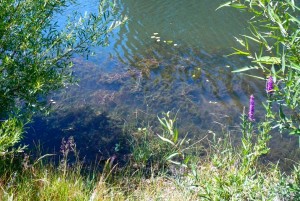Tahoe Keys answer to invasive weeds — herbicide
By Kathryn Reed
It’s time to do something different.
That was the overriding message delivered Tuesday night regarding invasive weeds that are taking over of the Tahoe Keys canals in South Lake Tahoe. Twenty-five years of various methods – most notably harvesting – have not solved the problem.
The Tahoe Keys Property Owners Association has spent about $250,000 developing a multi-year plan to control Eurasian milfoil, curlyleaf pondweed and coontail – the three primary invasive weeds. Estimates are that treatment could cost as much as $1 million.
Today the association spends about $400,000 a year on the harvester, which essentially is mowing the milfoil. It also upends particles that drift into Lake Tahoe proper – 4,000 per acre. Boat propellers are another way the weed gets into the bigger body of water.
The plan is to use herbicides over the course of five years to get rid of the bulk of the invasive weeds. It would be applied in conjunction with continued harvesting and placing barrier mats in locations to suffocate plants.
The draft plan was released Aug. 11, with comments on it being taken until Sept. 15. The plan has been vetted by a panel of five scientists, three who were at the meeting in person, with the other two participating remotely.
They are:
· Joe DiTomaso, non-crop weed specialist at UC Davis.
· Joel Trumbo, senior environmental scientist for the Lands Program for California Department of Fish and Wildlife.
· Kurt Getsinger, chairman of the Technical Advisory Committee of the Aquatic Ecosystem Restoration Foundation, member of the USDA’s IR-4 Project Aquatics Committee, and expert to the EPA Office of Pesticide Programs.
· Sudeep Chandra, at UNR does limnological studies related to the restoration or conservation of aquatic ecosystems.
· Pat Akers.
Collectively, they agree the plan is solid, especially liking that it is science based, there will be monitoring, and adaptive management will be used. That latter means if things aren’t going as planned, changes will be made mid-course. Using herbicides in the spring and not everywhere were also praised.
“The plan is well-thought out and researched. We feel the problems in the Keys are significant and some action has to be taken, and quickly,” DiTomaso said.
It was noted that these plants are invading waterways throughout the United States and that chemical applications have been used elsewhere. While each body of water is different, the Keys is not starting from scratch in terms of finding solutions.
Ultimately it will be up to the Lahontan Water Quality Control Board to issue a permit for the use of any herbicides, so it is not definitive this will happen. However, TKPOA would like to implement the plan in 2017. Environmental analysis would take place between now and then.
Many questions came up from the more than 80 people who attended Tuesday’s meeting regarding the safety of applying chemicals to the lagoons in terms of drinking water, and other plant and aquatic life.
John Larson, president of the TKPOA board, said if contaminants are found in the drinking water, one of the three wells the self-contained water company uses could be taken off-line. In a worst-case scenario, the Keys water system could get its water from South Tahoe Public Utility District.
As for killing native plants, it was noted the more than a dozen EPA approved herbicides that could possibly be used have particular attributes. It would be like applying a chemical to kill dandelions on a yard, but not killing the grass at the same time.
“Herbicides are toxic to plants. The converse is they are less risky to things that aren’t plants,” Trumbo said.
Killing the non-natives should also allow the natives to be healthier. These invasives are habitat for warm water fish, so eliminating their food source could help curtail their population.
No one expects the plants to be eradicated, but instead reduced to a level they can be controlled.
Still needing to be worked out is getting all the property owners on the same page. Within the Keys, besides the TKPOA, the Tahoe Keys Beach and Harbor Association, Tahoe Keys Marina, California Tahoe Conservancy, Tahoe Keys Village and lawyers who own the lagoon all have a say. And not all back the TKPOA plan.
—–
Notes:
· The plan is online, as is the ability to comment.

